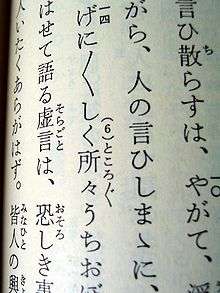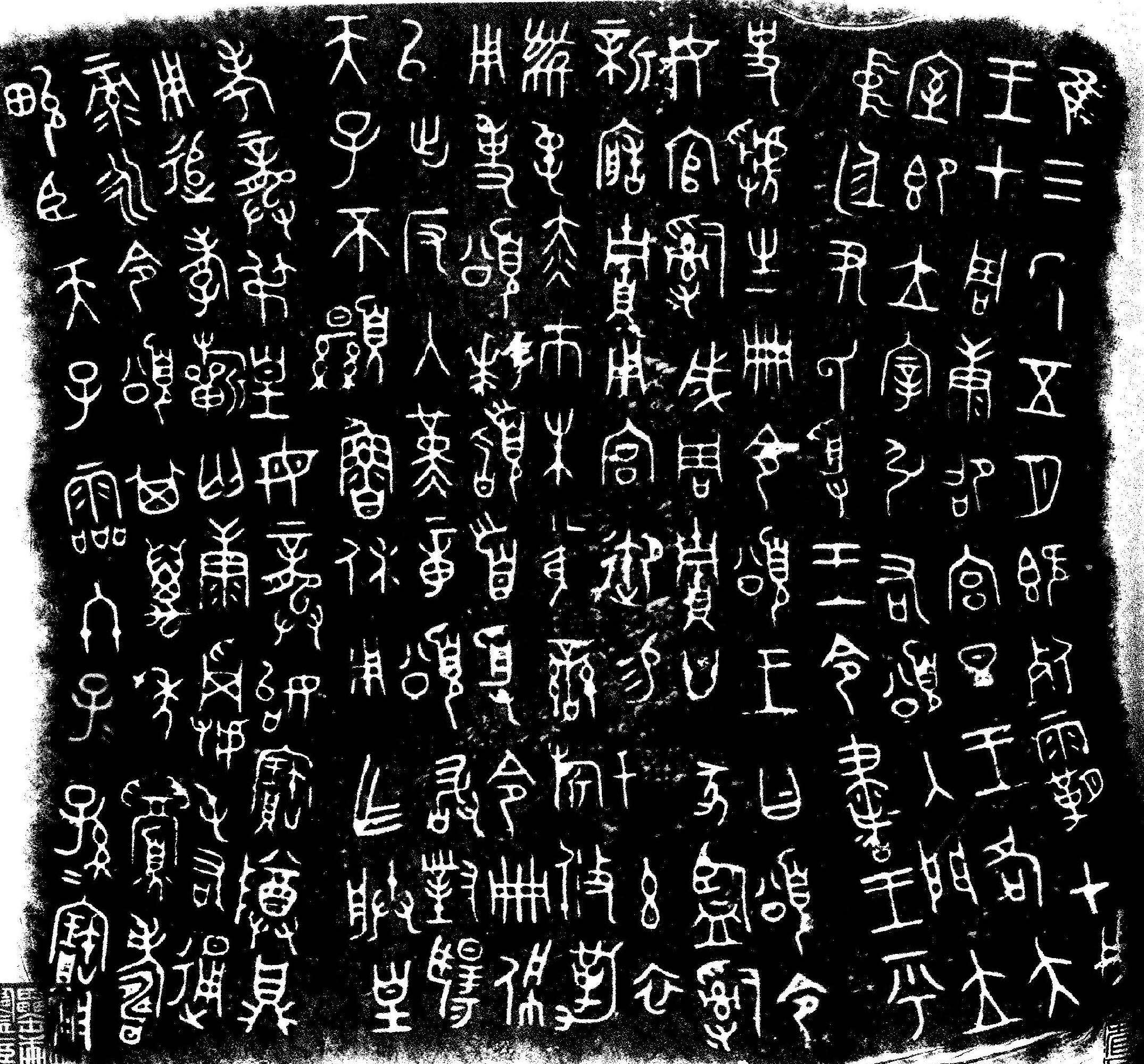Iteration mark
Iteration marks are characters or punctuation marks that represent a duplicated character or word.
Chinese
In Chinese, 二 (usually appearing as 〻) or 々 is used in casual writing to represent a doubled character. However, it is not used in formal writing anymore, and it never appeared in printed matter. In a tabulated table or list, vertical repetition can be represented by a ditto mark (〃).
History
Iteration marks have been occasionally used for more than two thousand years in China. The bronze script which is a kind of formal writing from the Zhou Dynasty, shown in excerpt to the right (click for the entire image of the full text), ends with “子二孫二寶用”, where the small 二 (“two”) is used as iteration marks in the phrase “子子孫孫寶用” ("descendants to use and to treasure").
In certain Malayo-Polynesian languages
In Filipino, Indonesian, and Malay words that are repeated can be shortened with the use of numeral "2". For example, kata-kata (words, from single 'kata') can be shortened to kata2, and jalan-jalan (to walk around, from single 'jalan') can be shortened to jalan2. The usage of "2" can also replaced with superscript "²" (e.g. kata² for kata2). The sign may also be used for reduplicated compound words with slight sound changes, for example hingar² for hingar-bingar (commotion). Suffixes may also be added after "2", for example in the word kebarat²an (western in nature, from the basic word barat (west) with the prefix ke- and suffix -an).[1]
The use of this mark dates back to the time when these languages were written with the Arabic script, specifically Jawi or Pegon variety. Using the Arabic numeral ٢, words such as رام رام (rama-rama, butterfly) can be shortened to رام٢. The use of Arabic numeral ٢ were also adapted to several Brahmi derived scripts of the Malay archipelago, notably Javanese,[2] Sundanese,[2] Lontara,[3] and Makassaran.[4] As the latin alphabet was introduced to the region, western style Arabic numeral "2" came to be use for latin-based orthography.
The use of "2" as an iteration mark was official in Indonesia up to 1972, as part of the Republican Spelling System. Its usage is discouraged when the Enhanced Indonesian Spelling System was adopted, and even though it commonly found in handwriting or old signage, it is considered to be inappropriate for formal writing and documents.[1]
Japanese
Japanese has various iteration marks for its three writing systems, namely kanji, hiragana, and katakana, but only the (horizontal) kanji iteration mark (々) is commonly used today.
In Japanese, iteration marks (Japanese: 踊り字 odoriji “dancing mark”, 重ね字 kasaneji, 繰り返し記号 kurikaeshikigō, or 反復記号 hanpukukigō, “repetition symbols”) are used to represent a duplicated character representing the same morpheme. For example, hitobito, "people", is usually written 人々, using the kanji for 人 with an iteration mark, 々, rather than 人人, using the same kanji twice, though this latter is allowed, and in this simple case might be used because it is easier to write. By contrast, while 日々 hibi "daily, day after day" is written with the iteration mark, as the morpheme is duplicated, 日日 hinichi "number of days, date" is written with the character duplicated, because it represents different morphemes (hi and nichi). Further, while hibi can in principle be written (confusingly) as 日日, hinichi cannot be written as ×日々, since that would imply repetition of the sound as well as the character. In potentially confusing examples such as this, readings can be disambiguated by writing words out in hiragana, so hinichi is often found as 日にち or even ひにち rather than 日日.
Note that sound changes can occur in duplication, which is not reflected in writing, such as 人 hito + 人 hito = 人々 hitobito (rendaku) or 刻 koku + 刻 koku = 刻々 kokkoku (gemination), though this is also pronounced kokukoku.
Kanji
The formal name of the kanji repetition symbol (々) is dōnojiten (同の字点) but is sometimes called noma (のま) because it looks like the katakana no (ノ) and ma (マ). This symbol originates from a simplified form of the character 仝, a variant of 同 ("same") written in the Grass Script style.[5]
Although Japanese kanji iteration marks are borrowed from Chinese, the grammatical function of duplication differs, as do the conventions on the use of these characters.
While Japanese does not have a grammatical plural form per se, some kanji can be reduplicated to indicate plurality (as a collective noun, not many individuals). This differs from Chinese, which normally repeats characters only for the purposes of adding emphasis, although there are some exceptions (e.g., 人 rén person, 人人 rénrén everybody).
- 人 hito—person; 人々 hitobito—people (not "persons")
- 山 yama—mountain; 山々 yamayama—many mountains
However, for some words duplication may alter the meaning:
- 個 ko—piece, object; 個々 koko—piece by piece, individually (also in Chinese)
- 時 toki—time; 時々 tokidoki—sometimes (meaning often in Chinese)
- 翌日 yokujitsu—next day; 翌々日 yokuyokujitsu—"next next day" (two days later)
Using 々 instead of repeating kanji is usually the preferred form, with two restrictions:
- the reading must be the same, possibly with sound change (as above), and
- the repetition must be within a single word.
When the reading is different, the second kanji is often simply written out to avoid confusion. Examples of such include:
- 日日 日にち hinichi
- 湯湯婆 湯たんぽ yutanpo
- 出出し 出だし dedashi
The repetition mark is not used in every case where two identical characters appear side by side, but only where the repetition itself is etymologically significant—when the repetition is part of a single morpheme (discrete word). Where a character ends up appearing twice as part of a compound, it is usually written out in full:
- 民主主義 minshu-shugi—"democracy", from 民主 + 主義 ("democratic" + "rule"); the abbreviated 民主々義 is only occasionally seen. One notable exception is in signs for neighborhood associations (町内会, chōnaikai) – the name of neighborhoods often end in "... neighborhood" (〜町, -chō), which is then suffixed with 〜町内会 yielding "... neighborhood neighborhood association" (〜町町内会, -chō-chōnaikai), which is then informally abbreviated to 〜町々内会, despite the word break.
Similarly, in certain Chinese borrowings, it is generally preferred to write out both characters, as in 九九 (ku-ku Chinese multiplication table) or 担担麺 (tan-tan-men dan dan noodles), though in practice 々 is often used.

In vertical writing, the character 〻 (Unicode U+303B), a cursive derivative of 二 ("two", as in Chinese, above), can be employed instead, although this is increasingly rare.
Kana
Kana uses different iteration marks; one for hiragana, ゝ, and one for katakana, ヽ. The hiragana iteration mark is seen in some personal names like さゝき Sasaki or おゝの Ōno, and it forms part of the formal name of the car company Isuzu (いすゞ).
Unlike the kanji iteration marks, which do not reflect sound changes, kana iteration marks closely reflect sound, and the kana iteration marks can be combined with the dakuten voicing mark to indicate that the repeated syllable should be voiced, for example みすゞ Misuzu. If the first syllable is already voiced, for example じじ jiji, the voiced repetition mark still needs to be used: じゞ rather than じゝ, which would be read as jishi.
While widespread in old Japanese texts, the kana iteration marks are generally not used in modern Japanese outside proper names, though they may appear in informal handwritten texts.
Repeating multiple characters

In addition to the single-character iteration marks, there are also two-character-sized repeat marks, which are used to repeat two or more characters. They are used in vertical writing only, and they are effectively obsolete in modern Japanese. The vertical kana repeat marks 〱 (unvoiced) and 〲 (voiced) resemble the hiragana character ku (く), giving them their name, kunojiten (くの字点). They stretch to fill the space typically occupied by two characters, but may indicate a repetition of more than two characters—they indicate that the preceding word or phrase be repeated. For example, the duplicated phrase 何とした何とした may be repeated as 何とした〱—note that here it repeats four characters. If a dakuten (voiced mark) is added, it applies to the first sound of the repeated word; this is written as 〲. For example, tokorodokoro could be written horizontally as ところ〲; the voiced iteration mark only applies to the first sound と.
In addition to the single-character representations U+3031 VERTICAL KANA REPEAT MARK and U+3032 VERTICAL KANA REPEAT WITH VOICED SOUND MARK, Unicode provides the half-character versions U+3033 〳 VERTICAL KANA REPEAT MARK UPPER HALF, U+3034 〴 VERTICAL KANA REPEAT WITH VOICED SOUND MARK UPPER HALF and U+3035 〵 VERTICAL KANA REPEAT MARK LOWER HALF, which can be stacked to render both voiced and unvoiced repeat marks:
〳 〵 | 〴 〵 |
As support for these is limited, the ordinary forward slash / and backward slash \ are occasionally used as substitutes.
Alternatively, multiple single-character iteration marks can be used, as in ところゞゝゝ tokorodokoro or 馬鹿々々しい bakabakashii. This practice is also uncommon in modern writing, though it is occasionally seen in horizontal writing as a substitute for the vertical repeat mark.
Unlike the single-kana iteration mark, if the first kana is voiced, the unvoiced version 〱 alone will repeat the voiced sound.
Further, if okurigana is present, then no iteration mark should be used, as in 休み休み. This is prescribed by the Japanese Ministry of Education in its 1981 Cabinet notification prescribes, rule #6—see okurigana article for elaboration.
Tangut
In Tangut manuscripts the sign 𖿠 is sometimes used to represent a doubled character; this sign does not occur in printed texts. In Unicode this character is U+16FE0 TANGUT ITERATION MARK, in the Ideographic Symbols and Punctuation block.
Egyptian hieroglyphs
In Egyptian hieroglyphs, the signs:
— zp(wj) sn(wj), literally meaning “two times”, repeat the previous sign or word.
Khmer, Thai and Lao
In Khmer, leiktō (ៗ) as for Thai, mai yamok (ๆ) and Lao, ko la (ໆ) represent a repeated syllable where as it besides the word. This used to be written as numeral two (២) and the form changed over time. A repeated word could be used either, to demonstrate plurality, to emphasize or to soften the meaning of the original word.
Ditto mark
In English, Spanish, French, Italian, German, Portuguese, Czech, Polish and Turkish lists, the ditto mark (″) represents a word repeated from the equivalent position in the line above it; or an evenly-spaced row of ditto marks represents any number of words repeated from above. For example:
- Two pounds of lettuce
- Three ″ ″ tomatoes
- Four ″ ″ onions
- One pound ″ carrots
This is common in handwriting and formerly in typewritten invoices etc.
In Unicode, the ditto mark of Western languages has been defined to be equivalent to the U+2033 ″ DOUBLE PRIME (HTML ″ · ″). The separate character U+3003 〃 DITTO MARK (HTML 〃) is to be used in the CJK scripts only.[6][7][8]
The convention in Polish handwriting, Czech, Swedish, and Austrian German is to use a ditto mark on the baseline together with em-dashes, for example:
- Dwa kilogramy pomidorów
- Trzy — „ — cebuli
- Cztery — „ — ziemniaków
See also
- Japanese typographic symbols
References
- "Dari Ejaan van Ophuijsen Hingga EYD" (in Indonesian). Archived from the original on 2012-01-30.
- Everson, Michael (2008-03-06). "L2/08-015R: Proposal for encoding the Javanese script in the UCS" (PDF).
- Everson, Michael. "Proposal for encoding the Lontara script in the UCS" (PDF).
- Pandey, Anshuman (2015-11-02). "L2/15-233: Proposal to encode the Makasar script in Unicode" (PDF).
- 漢字文化資料館 漢字Q&A〈旧版〉 Q0009 「々」はなんと読むのですか? (in Japanese).
- "Unicode Standard Annex #24: Unicode Script Property". 2.9 Script_Extensions Property. Retrieved 2013-05-19.
- "ScriptExtensions.txt". Retrieved 2013-05-19.
- "CJK symbols and Punctuation" (PDF). Retrieved 2013-05-20.
External links

